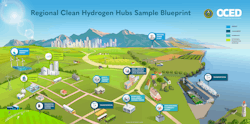U.S. Government Announces $7 Billion in Hydrogen Hub Funding: What's the Play for Data Center Operators?
While the pending availability of small modular nuclear reactors and microreactors has gotten the lion’s share of conversation about alternate power sources for data centers, hydrogen power generation has always been there, primarily as a footnote to the larger conversation on renewable power sources.
But last week the US Department of Energy Office of Clean Energy Demonstrations announced that it had selected seven regional participants for up to $7 billion in funding to accelerate the deployment of commercial-scale clean hydrogen production and its supporting infrastructure.
Hydrogen energy production isn’t new; some of us remember that hydrogen fuel cells were used in the Apollo moon landing missions. In fact, a problem with the fuel cells caused the crisis with the Apollo 13 mission that was immortalized in film.
In many ways that problem highlighted the reason that hydrogen power generation wasn’t more widely deployed in the last 50 years, the need for high-pressure storage, and the lack of places to refuel.
Those issues were the main reason that attempts at electric-powered automobiles driven by hydrogen fuel cells failed. That and the actual cost of the hydrogen due to the limited production facilities.
So Why Invest in a Hydrogen Production Infrastructure?
But the upside of hydrogen production is that you can use renewable energy to create it, such as wind and solar, so using the hydrogen created as a power source releases no CO2, so it has a zero carbon footprint to use for data center power.
And, at the moment, current technology allows for a kilogram of hydrogen in a fuel-cell to create 33kWh of electricity. So if the production costs, transport, and availability of hydrogen fuel can be successfully addressed, it can go a long way to meeting decarbonization goals on a wide scale.
The DOE predicts that the use of the product created by the seven regional facilities will reduce annual CO2 emissions by 25 million tons each year; roughly equivalent to the emissions of more than 5.5 million ICE vehicles.
Evaluating where and what projects to fund, the DOE focused primarily on these five areas of concern:
- Technical Merit and Impact, including the ability of the proposed hub to deploy infrastructure and produce at least 50-100 metric tons of clean hydrogen per day.
- Financial and Market Viability, concepts such as growth potential and market competitiveness.
- Workplan, how fast and comprehensively managed the proposed hub would be in production.
- Management Team and Project Partners, to guarantee a high chance of a successful deployment.
- Community Benefits Plan, the usual concerns about job creation, community involvement and long-term sustainability for that community.
The seven regions and their selected vendors are as follows:
Project Name: Appalachian Hydrogen Hub
Selectee name: Appalachian Regional Clean Hydrogen Hub (ARCH2)
Covering West Virginia, Ohio, and Pennsylvania, this site plans to leverage the easy availability of natural gas to power the production of low-cost hydrogen.
For more information, email [email protected].
Project Name: California Hydrogen Hub
Selectee name: Alliance for Renewable Clean Hydrogen Energy Systems (ARCHES)
Covering just the state of California, this site plans to do the hydrogen creation solely through the use of renewable energy and biomass.
For more information, email [email protected].
Project Name: Gulf Coast Hydrogen Hub
Selectee name: HyVelocity H2Hub
Covering the state of Texas, this site plans to use both natural gas with carbon capture and renewables-powered electrolysis, two of the existing renewables already in place.
For more information, email [email protected].
Project Name: Heartland Hydrogen Hub
Selectee name: Heartland Hub (HH2H)
Covering Minnesota, North Dakota, and South Dakota (and potentially neighboring states), the site will focus on using the current renewable energy production in place with a focus on decarbonizing the agricultural industry in the region.
For more information, email [email protected].
Project Name: Mid-Atlantic Hydrogen Hub
Selectee name: Mid-Atlantic Clean Hydrogen Hub (MACH2)
Focused on Pennsylvania, Delaware and New Jersey looks to use existing renewable and nuclear power to produce hydrogen and reuse much of the existing historic oil infrastructure, and existing rights-of-way to speed up the deployment of a hydrogen infrastructure.
For more information, email [email protected].
Project Name: Midwest Hydrogen Hub
Selectee name: Midwest Alliance for Clean Hydrogen (MachH2)
Covering the Illinois, Indiana, and Michigan areas, this site looks to focus on strategic hydrogen uses including steel and glass production, power generation, refining, heavy-duty transportation, and sustainable aviation fuel. The group believes that thius focus can reduce CO2 emmisions by almost 4 million metric tons per year.
For more information, email [email protected].
Project Name: Pacific Northwest Hydrogen Hub
Selectee name: PNW H2
Covering Washington, Oregon, and Montana this location plans to use existing renewable for the production of hydrogen exclusively by using electrolysis, with the added goal of reducing the cost of electrolyzers to all consumers by increasing the production levels of this type of equipment.
For more information, email [email protected].
Keep pace with the fast-moving world of data centers and cloud computing by connecting with Data Center Frontier on LinkedIn, following us on X/Twitter and Facebook, and signing up for our weekly newsletters using the form below.
About the Author



